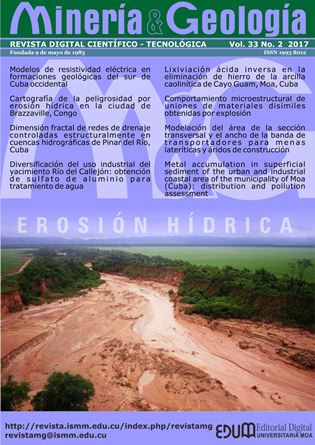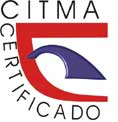Reverse Acid Leaching for Removal of Iron in Kaolinitic Clay in Cay Guam, Moa Cuba
Keywords:
caolinitic clay, chloride acid, reverse acid leaching, Cayo Guam ore body.Abstract
The objective of the study was to clean the kaolinitic clays in Cay Guam ore body through reverse acid leaching using chloride acid as a leach agent in order to clean the clay by eliminating the iron content. Techniques such as infrared and fluorescence spectrometry and X ray diffraction were applied during the characterization of the original raw material and after the reverse acid leaching process took place. The implementation of this method allowed extracting more than 98% of iron impurities, which resulted in obtaining a purer clay with silicon content of 60.48% and aluminum oxide of 49,50%. It was proved that the structure of the clay is not affected by reverse acid leaching and thus constitutes a method of beneficiation for kaolinites pigmented with iron.Downloads
References
AMBIKADEVI, V. R. & LALITHAMBIKA M. 2000: Effect of organic acids on ferric iron removal from iron-stained kaolinite. Applied Clay Science 16(3): 133-145.
CAMESELLE, C. 2007: Electrokinetic Bleaching of Kaolin Clay. 6th Symposium on electrokinetic remediation. Vigo, España, 12-15 de junio, p. 133-134.
EUN-YOU, L. & KYUNG-SUK, C. 1999: Microbial removal of Fe (III) impurities from clay using dissimilatory iron reducers. Bioscience and bioengineering 87(3): 397-399.
FONSECA, D. E.; GÓNGORA, E. & MARTÍNEZ, O. 2004: Evaluación de mezclas de arcillas de la región de Centeno, Moa, Cuba. Ingenierías 12(22): 45-54.
GONZÁLEZ, F. G.; SLAFER, G. A. & MIRALLES, D. J. 2003: Floret development and spike growth as affected by photoperiod during stem elongation in wheat. Field Crops Research 81(1): 29-38.
GONZÁLEZ, J. & RUIZ, M. D. 2006: Bleaching of kaolins and clays by chlorination of iron and titanium. Applied Clay Science 33(3): 219-229.
GONZÁLEZ, J. A.; PINO, E. & RUIZ, Y. M. 2003: Blanqueado de arcilla mediante la eliminación de hierro en la etapa de quemado. Jornada Sam/Conamet/Simposio Materia. Argentina Sam Luz.
HERNÁNDEZ, R. A.; LEGORRETA, F.; HERNÁNDEZ, L. E.; MATA, P. F.; OLIVERA, P. N. & MARTÍNEZ, A. 2011: Decoloración de arcillas caoliníferas por lixiviación para la obtención de caolín con alto índice de blancura. En: XX Congreso Internacional en Metalurgia Extractiva (Memorias). Hemosillo, Sonora, México, 18-20 de mayo.
JENA, P. K. & BROCCHI, E. A. 1997: Metal extraction through chlorine metallurgy. Mineral Processing and Extractive Metullargy Review 16(4): 211-237.
MAYO, O. & 2002: Geología de los yacimientos de arcillas para la cerámica. Quinta Conferencia Científico Técnica de la Construcción, Jornada Iberoamericana. La Habana. Editorial SOFTCAL, IR 824-831.
OROZCO, G. 1995. Caracterización de las arcillas de Cayo Guam. Informe técnico. Centro de Información. Instituto Superior Minero Metalúrgico, Moa.
PONS, J. A. & LEYVA, C. 1996: Empleo de las arcillas ferrocaoliníticas–gibbsíticas de la región de Moa en los talleres de fundición. Minería y Geología XIII(3): 93.
VEGLIO, F. & TORO, L. 1994: Process development of kaolin pressure bleaching using carbohydrates in acid media. Mineral processing 41(3-4): 239-255.
Published
How to Cite
Issue
Section
Copyright (c) 2017 Sergio Cabo de Villa-Figueiral, Amaury Palacios-Rodríguez, Miguel Garrido-Rodríguez

This work is licensed under a Creative Commons Attribution-NonCommercial 4.0 International License.
- Authors retain copyright and guaranteeing the right magazine to be the first publication of the work as licensed under a Creative Commons Attribution-NonCommercial that allows others to share the work with an acknowledgment of the work's authorship and initial publication in this journal.
- Authors may establish separate supplemental agreements for the exclusive distribution version of the work published in the journal (eg, place it in an institutional repository or publish it in a book), with an acknowledgment of its initial publication in this journal.
- Authors are allowed and recommended to disseminate their work through the Internet (e.g., in institutional telematic archives or on their websites) before and during the submission process, which can produce interesting exchanges and increase citations of the published work. (See The effect of open access)










